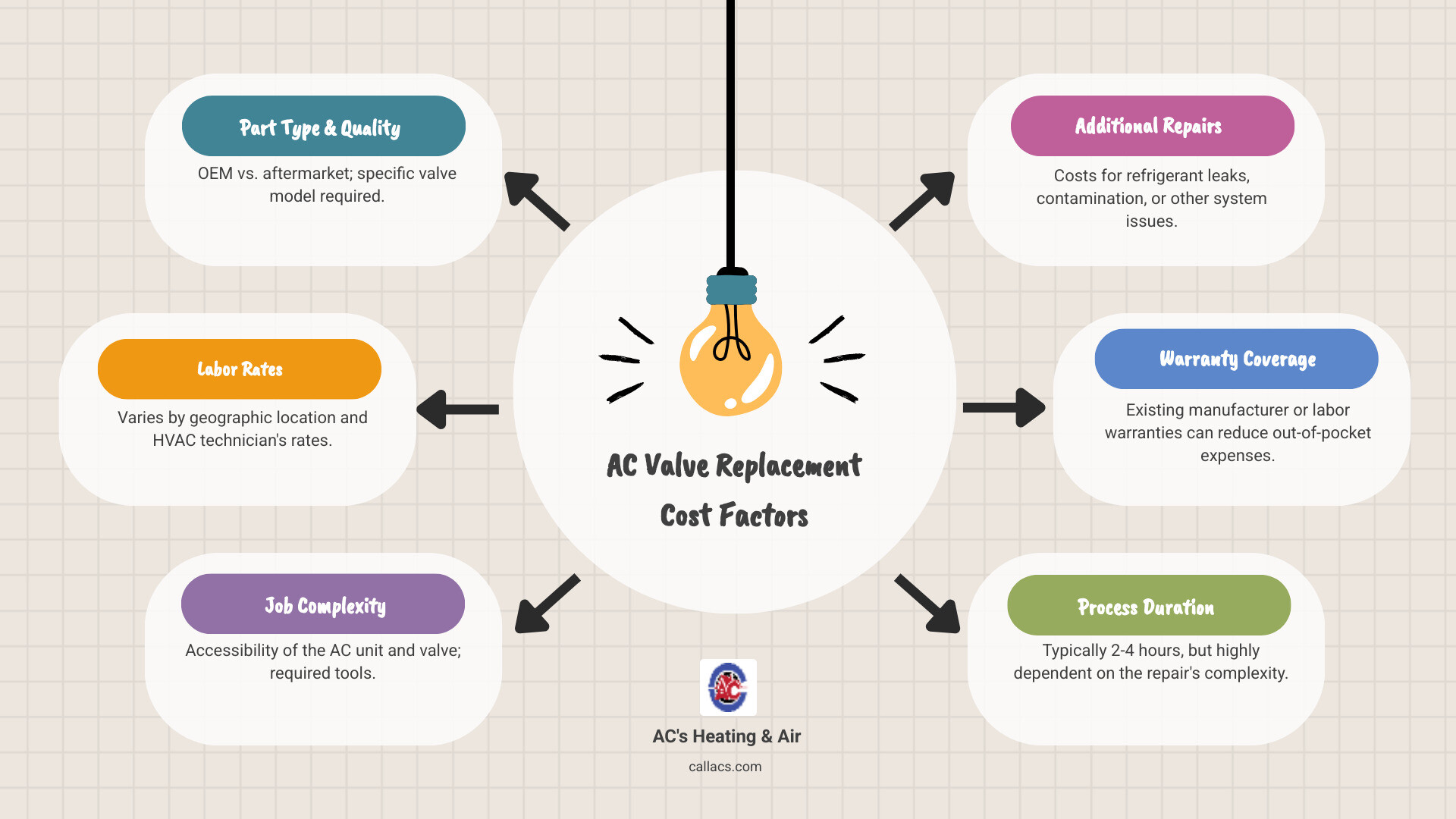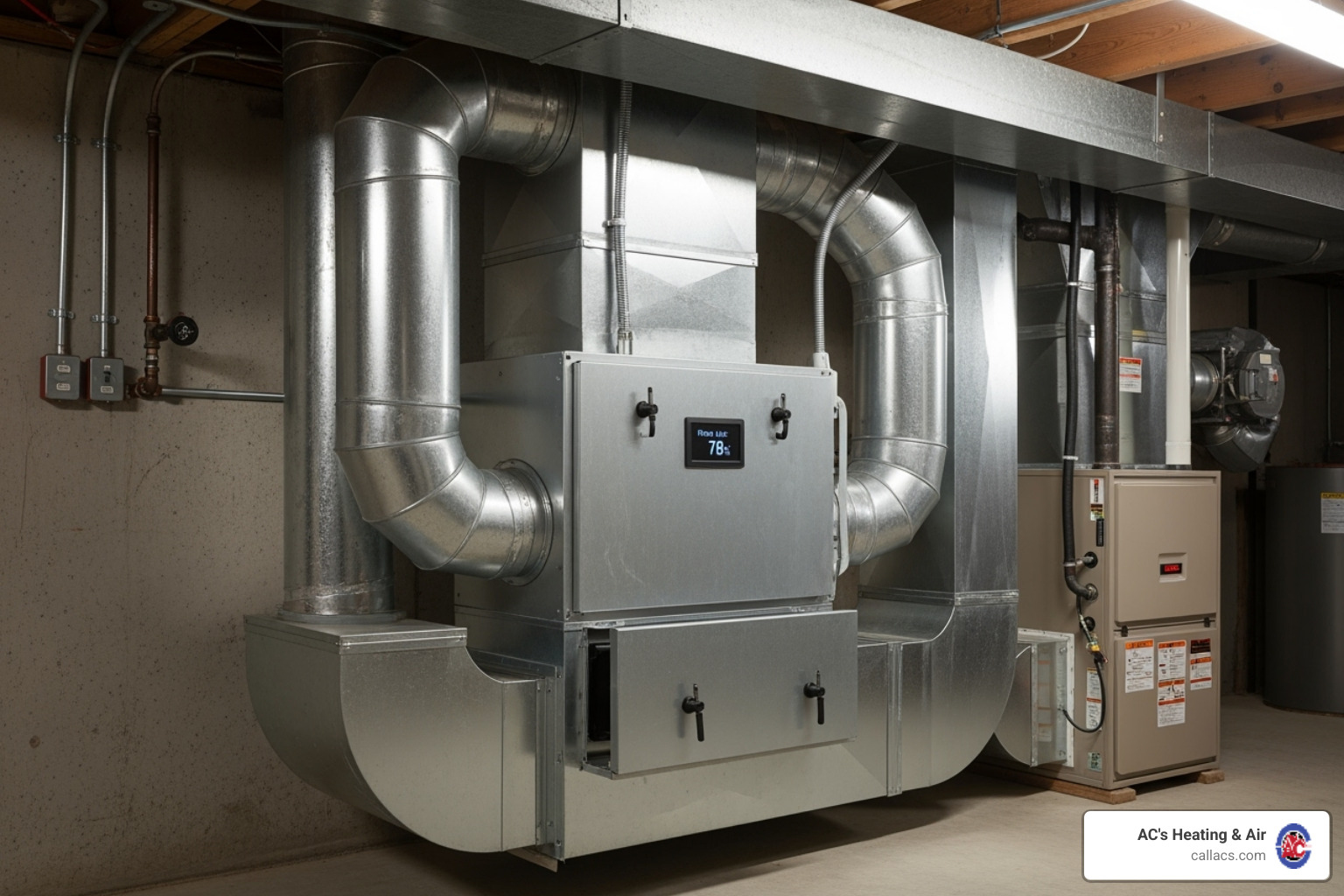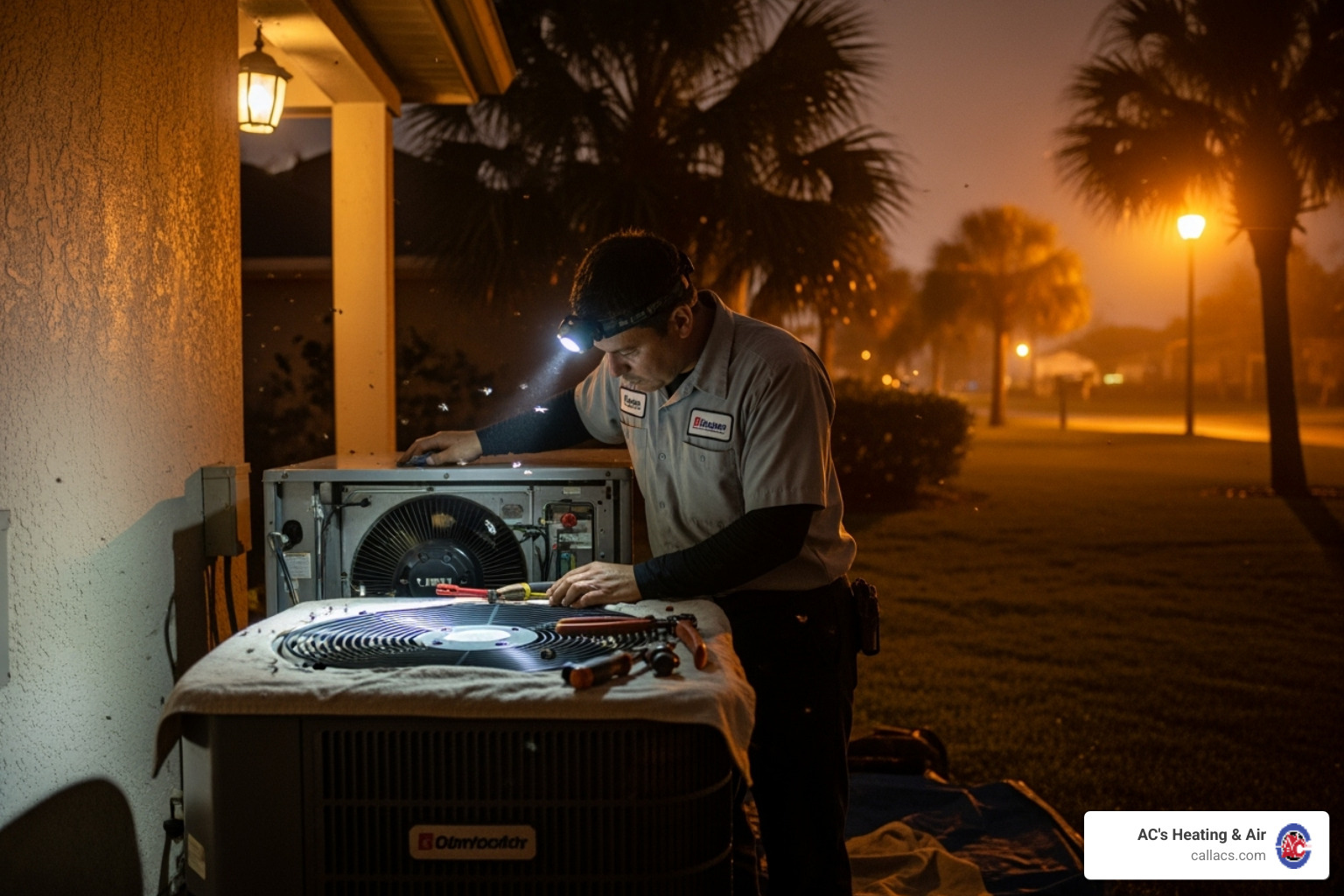Don't Sweat It—Your Guide to AC Unit Valve Replacement Pricing

Understanding AC Unit Valve Replacement: Your Essential Guide
The cost of an AC unit valve replacement can vary widely based on the valve type, labor rates, job complexity, additional repairs, and warranty coverage. When your air conditioner struggles to cool your home, a failing valve might be the culprit. These components control the refrigerant flow, which is vital for efficient cooling. Understanding the signs of trouble and what a replacement entails can save you time and money.
As Allen Chenault, owner of AC's Heating & Air, I know the importance of a properly functioning AC valve for reliable home comfort. With over 20+ years of HVAC experience, my mission is to provide top-notch cooling solutions that improve efficiency in every home.

Essential ac unit valve replacement terms:
What is an AC Expansion Valve and Why Does It Fail?
The expansion valve, often a Thermostatic Expansion Valve (TXV), is a critical component that controls the amount of liquid refrigerant entering the evaporator coil. Its job is to maintain optimal cooling efficiency by ensuring the refrigerant undergoes a pressure drop, changing from a high-pressure liquid to a low-pressure vapor. This process allows the refrigerant to absorb heat from your indoor air, cooling your home. The TXV constantly adjusts refrigerant flow based on temperature, ensuring consistent performance. A properly functioning TXV can improve an air conditioner's SEER (Seasonal Energy Efficiency Ratio) rating, highlighting its role in energy efficiency.

So, why do these vital components fail? Like any mechanical part, expansion valves can wear out. However, many failures stem from issues within the refrigerant system. If a compressor or drier fails, it can release debris into the refrigerant lines. These particles can clog the sensitive TXV. A clogged valve often indicates a deeper system issue. Other causes include improper installation or manufacturing defects. A malfunctioning TXV leads to inefficient cooling and poor performance, making an AC unit valve replacement necessary.
Common Symptoms of a Faulty AC Valve
Recognizing the signs of a failing valve is the first step to a solution. A malfunctioning TXV can manifest in several ways:
- Warm air from vents: If your AC is running but not cooling, a faulty TXV might be restricting refrigerant flow.
- Freezing evaporator coil: Ice on the indoor unit's coils often points to a TXV not allowing enough refrigerant into the evaporator. This causes the coil temperature to drop below freezing. Learn more in our guide on Air Conditioner Freezing Up.
- Unusual hissing sounds: This can indicate refrigerant struggling to pass through a restricted valve.
- Constant running or short cycling: The AC may run constantly or turn on and off frequently without cooling your space, driving up energy use. If your AC Runs But Not Cooling, a TXV could be the culprit.
- High humidity and energy bills: The system won't effectively remove moisture, and inefficient operation will lead to higher bills.
Types of AC Expansion Valves
While the Thermostatic Expansion Valve (TXV) is common, other types exist for various applications.
- Thermostatic Expansion Valve (TXV): This mechanical device uses a temperature-sensing bulb to meter refrigerant. There are two main types: Internally Equalized Valves for smaller systems and Externally Equalized Valves for larger HVAC systems, which offer more precise control.
- Electronic Expansion Valves (EEVs): Used in modern, high-efficiency systems, EEVs use a stepper motor for much finer control over refrigerant flow, optimizing performance. Studies show EEVs offer significant advantages over TXVs, as detailed in this Experimental comparison of electronic and thermostatic expansion valves.
- Fixed Orifice Tube: A simpler device found in older or less complex units, this is a fixed-size opening that meters refrigerant. It cannot adjust to changing conditions, making it less efficient than a TXV or EEV.
Knowing the valve type in your system is crucial for an accurate diagnosis and proper AC unit valve replacement.
Understanding the AC Unit Valve Replacement Cost Breakdown
When you need an AC unit valve replacement, it's natural to wonder about the cost. Homeowners can generally expect an investment in the mid-hundreds, but the price can range from a more modest sum to a more significant one depending on several factors.
The total cost breaks down into materials and labor. The new expansion valve itself can represent a good portion of the cost. Labor covers the technician's specialized skills and time, usually adding a few hundred dollars to the total. There can also be additional fees for essential steps like refrigerant recovery and recharge, which is legally required, or for any unexpected repairs found during the process. We believe in transparency, so you'll understand all potential charges upfront.

What Factors Influence the Cost of an AC unit valve replacement?
Several factors determine the final cost of your AC unit valve replacement:
- Labor Rates and Location: HVAC service costs vary by geographic area. In service cities such as Apopka, Winter Garden, Winter Park, Orlando, Celebration, Isleworth, and throughout Orange County, FL, rates can differ based on local market conditions. The time of year can also affect pricing, with emergency repairs during peak summer potentially costing more. Our Emergency AC Repair Services are always available.
- System Accessibility: The easier it is to access the valve, the less time the job takes, which can lower labor costs. A valve in a cramped attic or behind ductwork will increase labor time.
- AC Unit Size and Type: Larger or more complex systems often use more specialized, expensive expansion valves (e.g., TXV vs. EEV).
- OEM vs. Aftermarket Parts: Original Equipment Manufacturer (OEM) parts ensure a perfect fit and performance. While aftermarket parts may seem cheaper, they can cause compatibility issues. We typically recommend OEM parts for reliability.
- Warranty Coverage: If your AC unit is under warranty, the replacement part might be covered. However, labor costs are usually not included in manufacturer warranties. Always check your warranty documentation.
Potential Additional Repairs
A faulty expansion valve can sometimes be a symptom of a larger problem. Our technicians look for these potential issues to provide a comprehensive solution.
- Refrigerant Leaks: A malfunctioning TXV can stress the system, causing leaks. We must locate and repair any leaks, then recharge the system. This is crucial for performance and environmental safety. See our guide on Can Freezing Refrigerant Lines Damage HVAC?.
- Contaminated Refrigerant and Filter-Drier Replacement: If a failing component has introduced debris into the refrigerant, the system must be flushed. In such cases, the filter-drier, which removes moisture and contaminants, must also be replaced.
- Compressor Issues: A stuck TXV can damage the compressor, the heart of your AC. A valve stuck open can flood it with liquid, while a stuck-closed valve can cause it to overheat. The compressor may need repair or replacement. Learn more in our HVAC Compressor Troubleshooting guide.
- Electrical System Checks: We always perform thorough electrical checks to ensure all connections are secure and there are no underlying issues.
DIY vs. Professional Replacement
While tackling home repairs can be rewarding, an AC unit valve replacement is a complex task best left to professionals. This isn't a typical DIY project due to safety, legal requirements, and the risk of damaging your HVAC system.
Replacing an expansion valve involves handling refrigerants, which are controlled substances under federal law (EPA Section 608). It's illegal for uncertified individuals to handle them, and doing so can lead to hefty fines. There are also significant safety risks, including chemical burns from refrigerant and electrical shock from high-voltage components. A DIY attempt requires specialized tools like a refrigerant recovery machine, a vacuum pump, and manifold gauges. Without proper tools and training, you could contaminate your system, damage the compressor, or void your manufacturer's warranty.

Why Professional Installation is Recommended
Choosing a professional for your AC unit valve replacement ensures the job is done correctly, safely, and efficiently. Our certified technicians at AC's Heating & Air bring experience and the right equipment to every job.
- Proper Diagnosis: We accurately determine if the valve is the true culprit, preventing unnecessary repairs.
- Correct Part Selection: We select the exact OEM part for your specific unit to ensure a perfect fit and optimal performance.
- Brazing and Soldering: This skill is essential for creating leak-proof seals when connecting refrigerant lines.
- System Evacuation: We use a vacuum pump to remove all air and moisture, which can form corrosive acids if left in the system.
- Precise Refrigerant Charging & Leak Testing: We recharge the system with the exact amount of refrigerant and test for leaks to ensure peak performance and reliability.
Our Air Conditioning Repair Services provide peace of mind that your system will run smoothly for years.
What is the step-by-step process for an AC unit valve replacement?
Our technicians follow a meticulous process for every ac unit valve replacement:
- System Diagnosis: First, we confirm the expansion valve is faulty using specialized diagnostic tools.
- Power Shut-off: We turn off all power to the AC system at the breaker for safety.
- Refrigerant Recovery: We safely recover all refrigerant from the system according to EPA regulations.
- Old Valve Removal: The faulty valve is carefully unbrazed and removed from the refrigerant lines.
- New Valve Installation: The new valve is brazed into place, creating an airtight, leak-proof seal.
- Sensing Bulb Placement: For a TXV, the sensing bulb is securely attached to the suction line to ensure accurate temperature readings.
- System Vacuuming: A powerful vacuum pump removes all air and moisture from the lines. We then perform a leak check.
- Recharging with Refrigerant: The system is recharged with the precise type and amount of refrigerant specified by the manufacturer.
- Testing: We turn the system on and test superheat and subcooling values to confirm the new valve is working correctly and the system is operating at peak efficiency.
Frequently Asked Questions about AC Valve Replacement
Homeowners often have questions about repairs like an AC unit valve replacement. Here are answers to some of the most common ones we receive.
How long does an AC expansion valve last?
An AC expansion valve is quite durable, typically lasting 10 to 15 years with proper installation and regular maintenance. A well-maintained system free from debris and with the correct refrigerant charge puts less stress on the valve. Factors like frequent short cycling or contaminated refrigerant can shorten its lifespan. This is why regular AC Maintenance Services are so important for extending the life of all your system's components.
How long does it take to replace an AC expansion valve?
For a skilled technician, an AC unit valve replacement typically takes between two to four hours. This timeframe includes all the necessary steps: recovering the old refrigerant, evacuating the system to remove air and moisture, and precisely recharging it. The exact duration can depend on the accessibility of the valve and whether any additional repairs, like fixing a small leak, are needed.
Does my warranty cover an AC expansion valve replacement?
Your warranty can certainly help with the cost. Most new AC units come with a manufacturer's parts warranty, often for 1 to 5 years, which may cover the cost of a new expansion valve if it fails due to a defect. However, it's crucial to know that manufacturer warranties typically do not cover the labor costs. A separate labor warranty, often provided by the installer, might cover that. Always review your warranty documents to understand what's covered and any conditions, such as required annual maintenance.
Protect Your Investment and Save Money
Your air conditioning system is a significant investment in your home's comfort. Protecting it and saving money comes down to proactive care. Whether you need an AC unit valve replacement or other services, preventative action is always better than reacting to a breakdown.
One of the best ways to save is through preventative maintenance. Regular check-ups can spot small issues before they become costly failures. A well-maintained system runs more efficiently, lowering your energy bills. For example, a properly tuned TXV ensures optimal refrigerant flow, improving performance as shown by studies on the Effect of thermostatic expansion valve tuning on performance. Scheduling maintenance during off-peak seasons can also offer more flexibility and potential savings.
At AC's Heating & Air, we offer comprehensive HVAC Preventive Maintenance Plans for homes in Apopka, Winter Park, Orlando, and throughout Orange County, FL. These plans are designed to improve efficiency, extend your unit's lifespan, and reduce the risk of surprise breakdowns. While maintenance can't prevent all part failures, it greatly reduces the risk and helps us catch problems early, often leading to a simpler, less expensive fix.
Taking care of your AC is an investment in your comfort and your equipment's longevity. When it's eventually time for an HVAC Unit Replacement, you'll know you got the most out of your current system.



